Project Management: Queensland Mine Safety and Legislation
VerifiedAdded on 2023/03/30
|10
|2217
|215
AI Summary
This assignment discusses the safety management system in mines, focusing on the Queensland mine safety framework and legislation. It covers topics such as dust management, principal mining hazards, and safety procedures to control fatalities. The assignment also addresses the environmental management of noise, dust, sewage, and waste water.
Contribute Materials
Your contribution can guide someone’s learning journey. Share your
documents today.
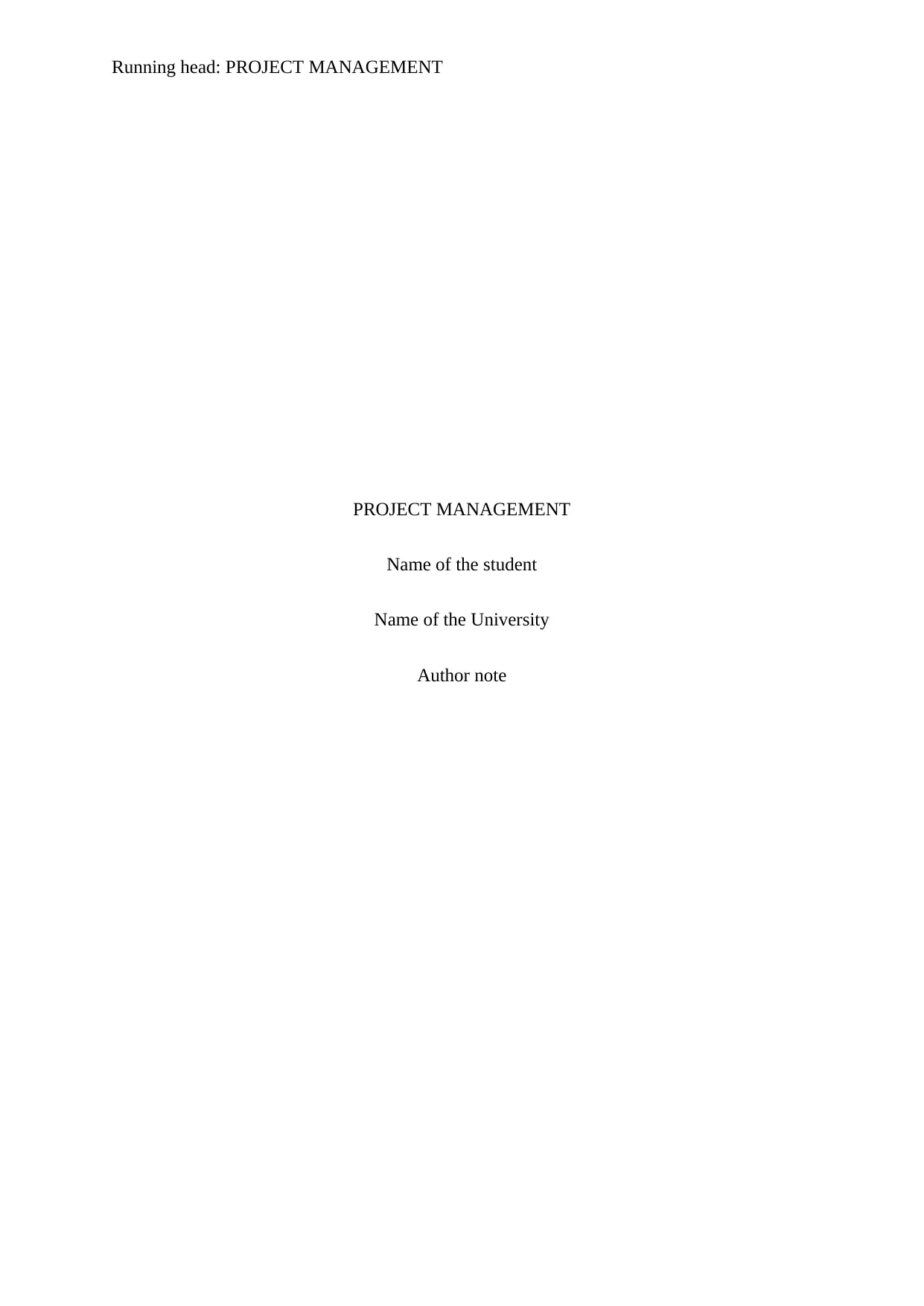
Running head: PROJECT MANAGEMENT
PROJECT MANAGEMENT
Name of the student
Name of the University
Author note
PROJECT MANAGEMENT
Name of the student
Name of the University
Author note
Secure Best Marks with AI Grader
Need help grading? Try our AI Grader for instant feedback on your assignments.
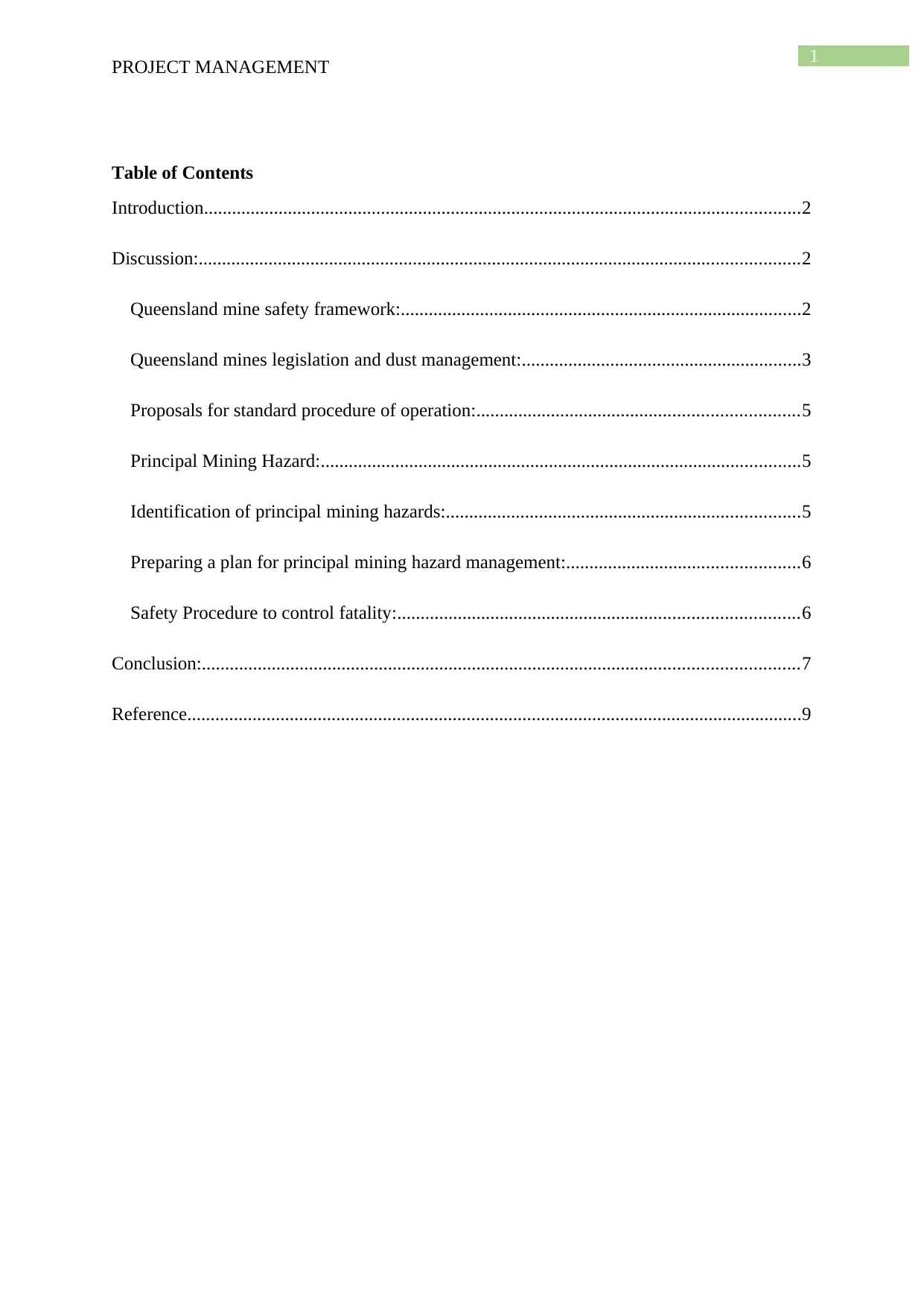
1
PROJECT MANAGEMENT
Table of Contents
Introduction................................................................................................................................2
Discussion:.................................................................................................................................2
Queensland mine safety framework:......................................................................................2
Queensland mines legislation and dust management:............................................................3
Proposals for standard procedure of operation:.....................................................................5
Principal Mining Hazard:.......................................................................................................5
Identification of principal mining hazards:............................................................................5
Preparing a plan for principal mining hazard management:..................................................6
Safety Procedure to control fatality:......................................................................................6
Conclusion:................................................................................................................................7
Reference....................................................................................................................................9
PROJECT MANAGEMENT
Table of Contents
Introduction................................................................................................................................2
Discussion:.................................................................................................................................2
Queensland mine safety framework:......................................................................................2
Queensland mines legislation and dust management:............................................................3
Proposals for standard procedure of operation:.....................................................................5
Principal Mining Hazard:.......................................................................................................5
Identification of principal mining hazards:............................................................................5
Preparing a plan for principal mining hazard management:..................................................6
Safety Procedure to control fatality:......................................................................................6
Conclusion:................................................................................................................................7
Reference....................................................................................................................................9
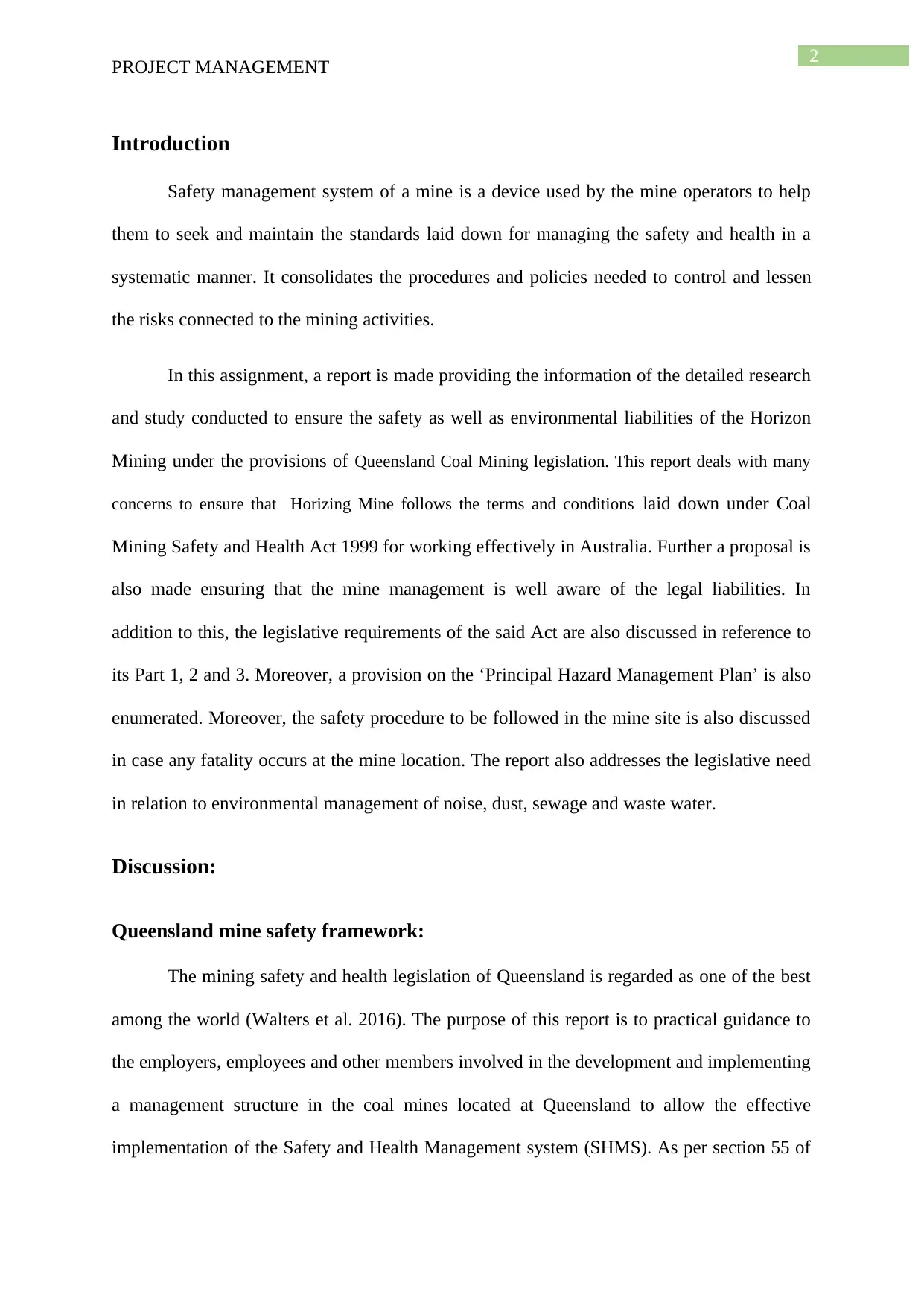
2
PROJECT MANAGEMENT
Introduction
Safety management system of a mine is a device used by the mine operators to help
them to seek and maintain the standards laid down for managing the safety and health in a
systematic manner. It consolidates the procedures and policies needed to control and lessen
the risks connected to the mining activities.
In this assignment, a report is made providing the information of the detailed research
and study conducted to ensure the safety as well as environmental liabilities of the Horizon
Mining under the provisions of Queensland Coal Mining legislation. This report deals with many
concerns to ensure that Horizing Mine follows the terms and conditions laid down under Coal
Mining Safety and Health Act 1999 for working effectively in Australia. Further a proposal is
also made ensuring that the mine management is well aware of the legal liabilities. In
addition to this, the legislative requirements of the said Act are also discussed in reference to
its Part 1, 2 and 3. Moreover, a provision on the ‘Principal Hazard Management Plan’ is also
enumerated. Moreover, the safety procedure to be followed in the mine site is also discussed
in case any fatality occurs at the mine location. The report also addresses the legislative need
in relation to environmental management of noise, dust, sewage and waste water.
Discussion:
Queensland mine safety framework:
The mining safety and health legislation of Queensland is regarded as one of the best
among the world (Walters et al. 2016). The purpose of this report is to practical guidance to
the employers, employees and other members involved in the development and implementing
a management structure in the coal mines located at Queensland to allow the effective
implementation of the Safety and Health Management system (SHMS). As per section 55 of
PROJECT MANAGEMENT
Introduction
Safety management system of a mine is a device used by the mine operators to help
them to seek and maintain the standards laid down for managing the safety and health in a
systematic manner. It consolidates the procedures and policies needed to control and lessen
the risks connected to the mining activities.
In this assignment, a report is made providing the information of the detailed research
and study conducted to ensure the safety as well as environmental liabilities of the Horizon
Mining under the provisions of Queensland Coal Mining legislation. This report deals with many
concerns to ensure that Horizing Mine follows the terms and conditions laid down under Coal
Mining Safety and Health Act 1999 for working effectively in Australia. Further a proposal is
also made ensuring that the mine management is well aware of the legal liabilities. In
addition to this, the legislative requirements of the said Act are also discussed in reference to
its Part 1, 2 and 3. Moreover, a provision on the ‘Principal Hazard Management Plan’ is also
enumerated. Moreover, the safety procedure to be followed in the mine site is also discussed
in case any fatality occurs at the mine location. The report also addresses the legislative need
in relation to environmental management of noise, dust, sewage and waste water.
Discussion:
Queensland mine safety framework:
The mining safety and health legislation of Queensland is regarded as one of the best
among the world (Walters et al. 2016). The purpose of this report is to practical guidance to
the employers, employees and other members involved in the development and implementing
a management structure in the coal mines located at Queensland to allow the effective
implementation of the Safety and Health Management system (SHMS). As per section 55 of
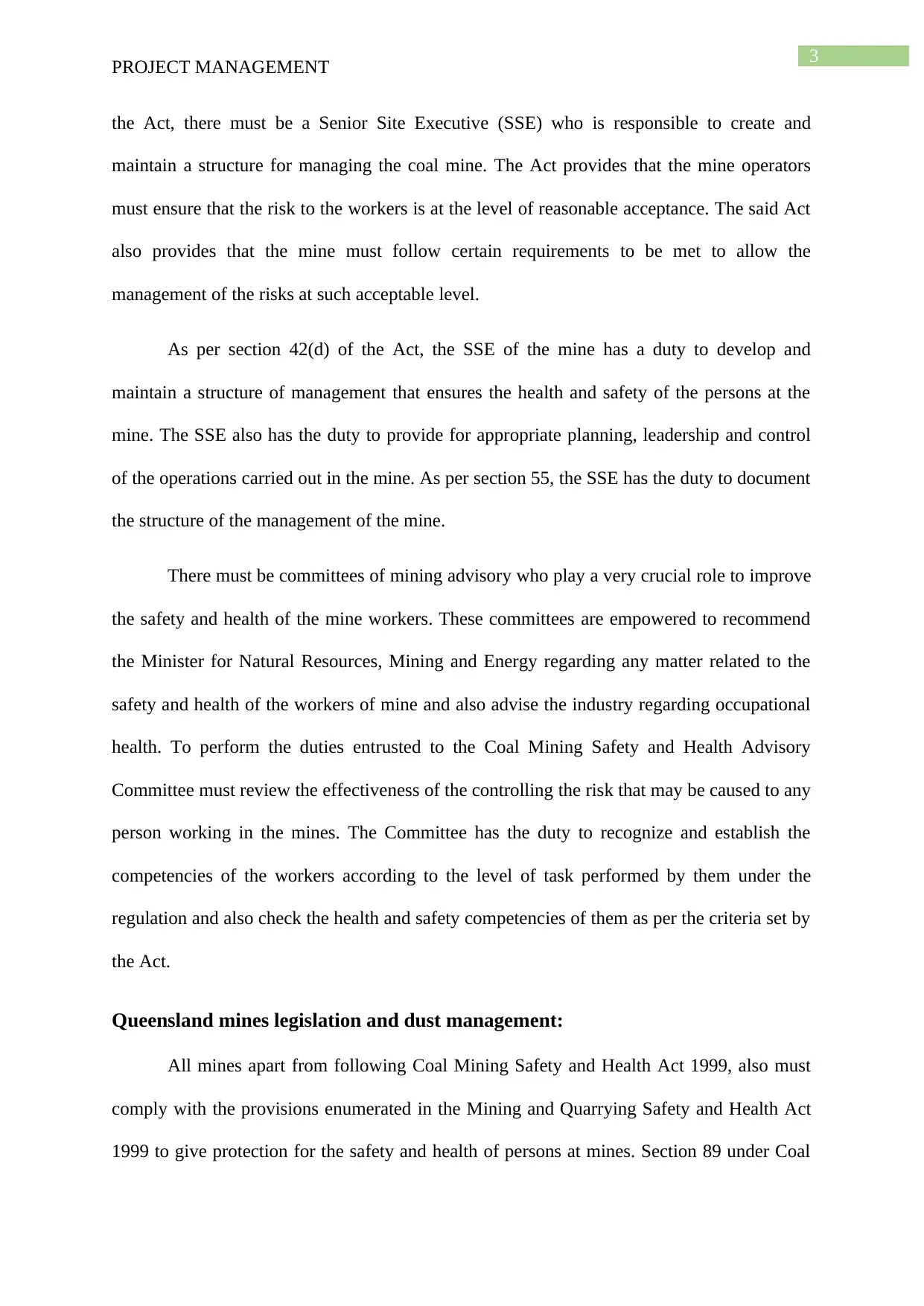
3
PROJECT MANAGEMENT
the Act, there must be a Senior Site Executive (SSE) who is responsible to create and
maintain a structure for managing the coal mine. The Act provides that the mine operators
must ensure that the risk to the workers is at the level of reasonable acceptance. The said Act
also provides that the mine must follow certain requirements to be met to allow the
management of the risks at such acceptable level.
As per section 42(d) of the Act, the SSE of the mine has a duty to develop and
maintain a structure of management that ensures the health and safety of the persons at the
mine. The SSE also has the duty to provide for appropriate planning, leadership and control
of the operations carried out in the mine. As per section 55, the SSE has the duty to document
the structure of the management of the mine.
There must be committees of mining advisory who play a very crucial role to improve
the safety and health of the mine workers. These committees are empowered to recommend
the Minister for Natural Resources, Mining and Energy regarding any matter related to the
safety and health of the workers of mine and also advise the industry regarding occupational
health. To perform the duties entrusted to the Coal Mining Safety and Health Advisory
Committee must review the effectiveness of the controlling the risk that may be caused to any
person working in the mines. The Committee has the duty to recognize and establish the
competencies of the workers according to the level of task performed by them under the
regulation and also check the health and safety competencies of them as per the criteria set by
the Act.
Queensland mines legislation and dust management:
All mines apart from following Coal Mining Safety and Health Act 1999, also must
comply with the provisions enumerated in the Mining and Quarrying Safety and Health Act
1999 to give protection for the safety and health of persons at mines. Section 89 under Coal
PROJECT MANAGEMENT
the Act, there must be a Senior Site Executive (SSE) who is responsible to create and
maintain a structure for managing the coal mine. The Act provides that the mine operators
must ensure that the risk to the workers is at the level of reasonable acceptance. The said Act
also provides that the mine must follow certain requirements to be met to allow the
management of the risks at such acceptable level.
As per section 42(d) of the Act, the SSE of the mine has a duty to develop and
maintain a structure of management that ensures the health and safety of the persons at the
mine. The SSE also has the duty to provide for appropriate planning, leadership and control
of the operations carried out in the mine. As per section 55, the SSE has the duty to document
the structure of the management of the mine.
There must be committees of mining advisory who play a very crucial role to improve
the safety and health of the mine workers. These committees are empowered to recommend
the Minister for Natural Resources, Mining and Energy regarding any matter related to the
safety and health of the workers of mine and also advise the industry regarding occupational
health. To perform the duties entrusted to the Coal Mining Safety and Health Advisory
Committee must review the effectiveness of the controlling the risk that may be caused to any
person working in the mines. The Committee has the duty to recognize and establish the
competencies of the workers according to the level of task performed by them under the
regulation and also check the health and safety competencies of them as per the criteria set by
the Act.
Queensland mines legislation and dust management:
All mines apart from following Coal Mining Safety and Health Act 1999, also must
comply with the provisions enumerated in the Mining and Quarrying Safety and Health Act
1999 to give protection for the safety and health of persons at mines. Section 89 under Coal
Secure Best Marks with AI Grader
Need help grading? Try our AI Grader for instant feedback on your assignments.
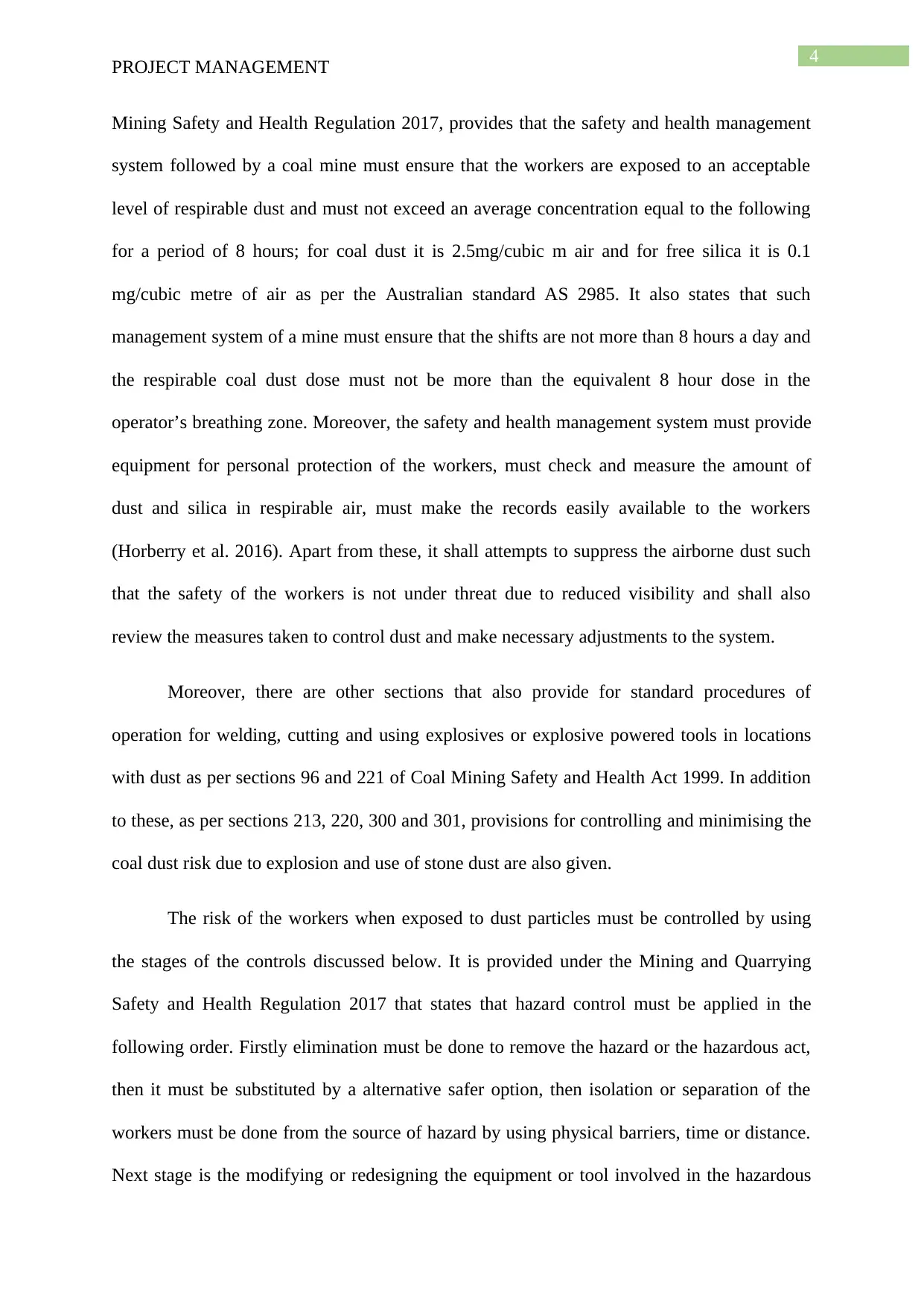
4
PROJECT MANAGEMENT
Mining Safety and Health Regulation 2017, provides that the safety and health management
system followed by a coal mine must ensure that the workers are exposed to an acceptable
level of respirable dust and must not exceed an average concentration equal to the following
for a period of 8 hours; for coal dust it is 2.5mg/cubic m air and for free silica it is 0.1
mg/cubic metre of air as per the Australian standard AS 2985. It also states that such
management system of a mine must ensure that the shifts are not more than 8 hours a day and
the respirable coal dust dose must not be more than the equivalent 8 hour dose in the
operator’s breathing zone. Moreover, the safety and health management system must provide
equipment for personal protection of the workers, must check and measure the amount of
dust and silica in respirable air, must make the records easily available to the workers
(Horberry et al. 2016). Apart from these, it shall attempts to suppress the airborne dust such
that the safety of the workers is not under threat due to reduced visibility and shall also
review the measures taken to control dust and make necessary adjustments to the system.
Moreover, there are other sections that also provide for standard procedures of
operation for welding, cutting and using explosives or explosive powered tools in locations
with dust as per sections 96 and 221 of Coal Mining Safety and Health Act 1999. In addition
to these, as per sections 213, 220, 300 and 301, provisions for controlling and minimising the
coal dust risk due to explosion and use of stone dust are also given.
The risk of the workers when exposed to dust particles must be controlled by using
the stages of the controls discussed below. It is provided under the Mining and Quarrying
Safety and Health Regulation 2017 that states that hazard control must be applied in the
following order. Firstly elimination must be done to remove the hazard or the hazardous act,
then it must be substituted by a alternative safer option, then isolation or separation of the
workers must be done from the source of hazard by using physical barriers, time or distance.
Next stage is the modifying or redesigning the equipment or tool involved in the hazardous
PROJECT MANAGEMENT
Mining Safety and Health Regulation 2017, provides that the safety and health management
system followed by a coal mine must ensure that the workers are exposed to an acceptable
level of respirable dust and must not exceed an average concentration equal to the following
for a period of 8 hours; for coal dust it is 2.5mg/cubic m air and for free silica it is 0.1
mg/cubic metre of air as per the Australian standard AS 2985. It also states that such
management system of a mine must ensure that the shifts are not more than 8 hours a day and
the respirable coal dust dose must not be more than the equivalent 8 hour dose in the
operator’s breathing zone. Moreover, the safety and health management system must provide
equipment for personal protection of the workers, must check and measure the amount of
dust and silica in respirable air, must make the records easily available to the workers
(Horberry et al. 2016). Apart from these, it shall attempts to suppress the airborne dust such
that the safety of the workers is not under threat due to reduced visibility and shall also
review the measures taken to control dust and make necessary adjustments to the system.
Moreover, there are other sections that also provide for standard procedures of
operation for welding, cutting and using explosives or explosive powered tools in locations
with dust as per sections 96 and 221 of Coal Mining Safety and Health Act 1999. In addition
to these, as per sections 213, 220, 300 and 301, provisions for controlling and minimising the
coal dust risk due to explosion and use of stone dust are also given.
The risk of the workers when exposed to dust particles must be controlled by using
the stages of the controls discussed below. It is provided under the Mining and Quarrying
Safety and Health Regulation 2017 that states that hazard control must be applied in the
following order. Firstly elimination must be done to remove the hazard or the hazardous act,
then it must be substituted by a alternative safer option, then isolation or separation of the
workers must be done from the source of hazard by using physical barriers, time or distance.
Next stage is the modifying or redesigning the equipment or tool involved in the hazardous
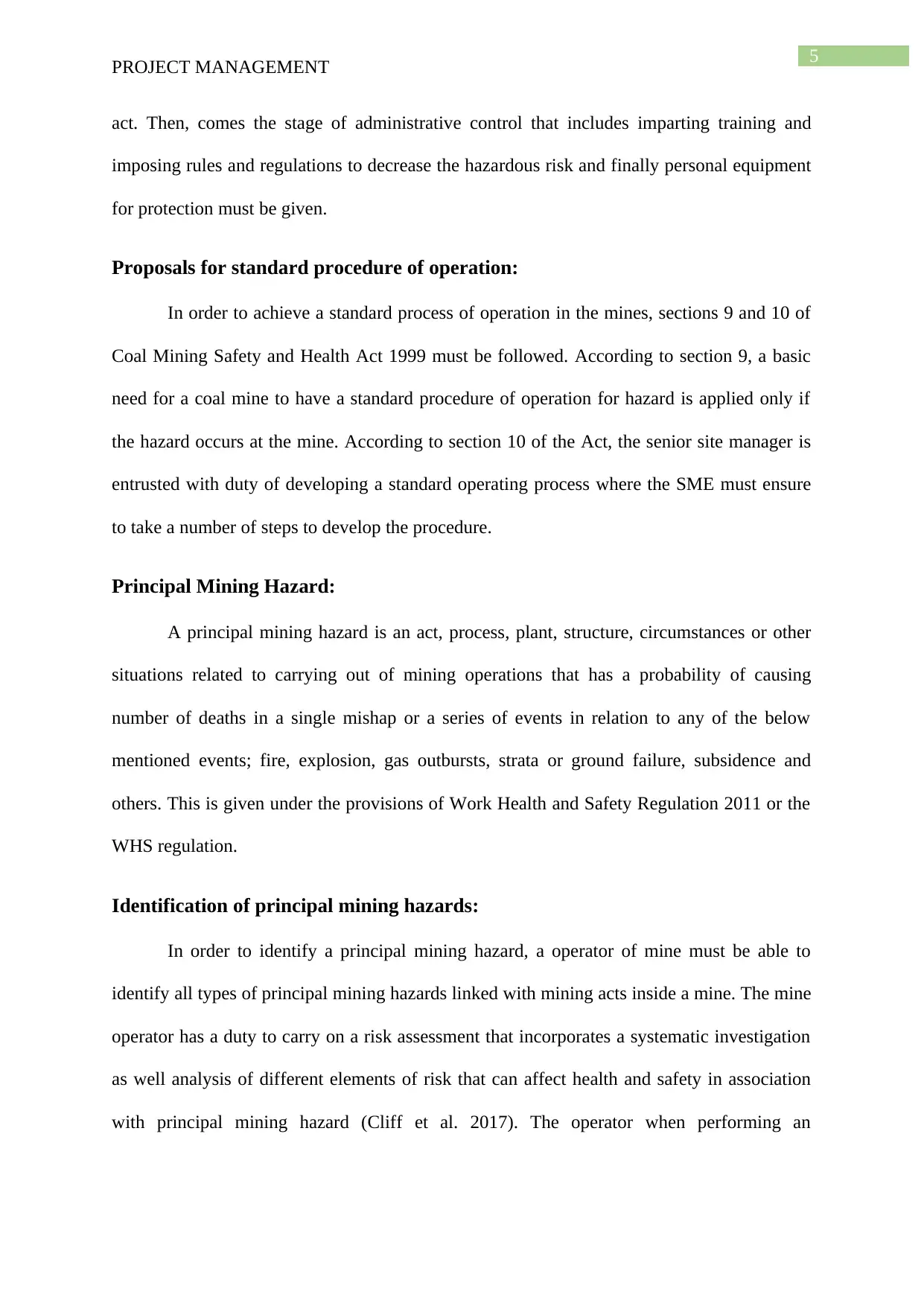
5
PROJECT MANAGEMENT
act. Then, comes the stage of administrative control that includes imparting training and
imposing rules and regulations to decrease the hazardous risk and finally personal equipment
for protection must be given.
Proposals for standard procedure of operation:
In order to achieve a standard process of operation in the mines, sections 9 and 10 of
Coal Mining Safety and Health Act 1999 must be followed. According to section 9, a basic
need for a coal mine to have a standard procedure of operation for hazard is applied only if
the hazard occurs at the mine. According to section 10 of the Act, the senior site manager is
entrusted with duty of developing a standard operating process where the SME must ensure
to take a number of steps to develop the procedure.
Principal Mining Hazard:
A principal mining hazard is an act, process, plant, structure, circumstances or other
situations related to carrying out of mining operations that has a probability of causing
number of deaths in a single mishap or a series of events in relation to any of the below
mentioned events; fire, explosion, gas outbursts, strata or ground failure, subsidence and
others. This is given under the provisions of Work Health and Safety Regulation 2011 or the
WHS regulation.
Identification of principal mining hazards:
In order to identify a principal mining hazard, a operator of mine must be able to
identify all types of principal mining hazards linked with mining acts inside a mine. The mine
operator has a duty to carry on a risk assessment that incorporates a systematic investigation
as well analysis of different elements of risk that can affect health and safety in association
with principal mining hazard (Cliff et al. 2017). The operator when performing an
PROJECT MANAGEMENT
act. Then, comes the stage of administrative control that includes imparting training and
imposing rules and regulations to decrease the hazardous risk and finally personal equipment
for protection must be given.
Proposals for standard procedure of operation:
In order to achieve a standard process of operation in the mines, sections 9 and 10 of
Coal Mining Safety and Health Act 1999 must be followed. According to section 9, a basic
need for a coal mine to have a standard procedure of operation for hazard is applied only if
the hazard occurs at the mine. According to section 10 of the Act, the senior site manager is
entrusted with duty of developing a standard operating process where the SME must ensure
to take a number of steps to develop the procedure.
Principal Mining Hazard:
A principal mining hazard is an act, process, plant, structure, circumstances or other
situations related to carrying out of mining operations that has a probability of causing
number of deaths in a single mishap or a series of events in relation to any of the below
mentioned events; fire, explosion, gas outbursts, strata or ground failure, subsidence and
others. This is given under the provisions of Work Health and Safety Regulation 2011 or the
WHS regulation.
Identification of principal mining hazards:
In order to identify a principal mining hazard, a operator of mine must be able to
identify all types of principal mining hazards linked with mining acts inside a mine. The mine
operator has a duty to carry on a risk assessment that incorporates a systematic investigation
as well analysis of different elements of risk that can affect health and safety in association
with principal mining hazard (Cliff et al. 2017). The operator when performing an
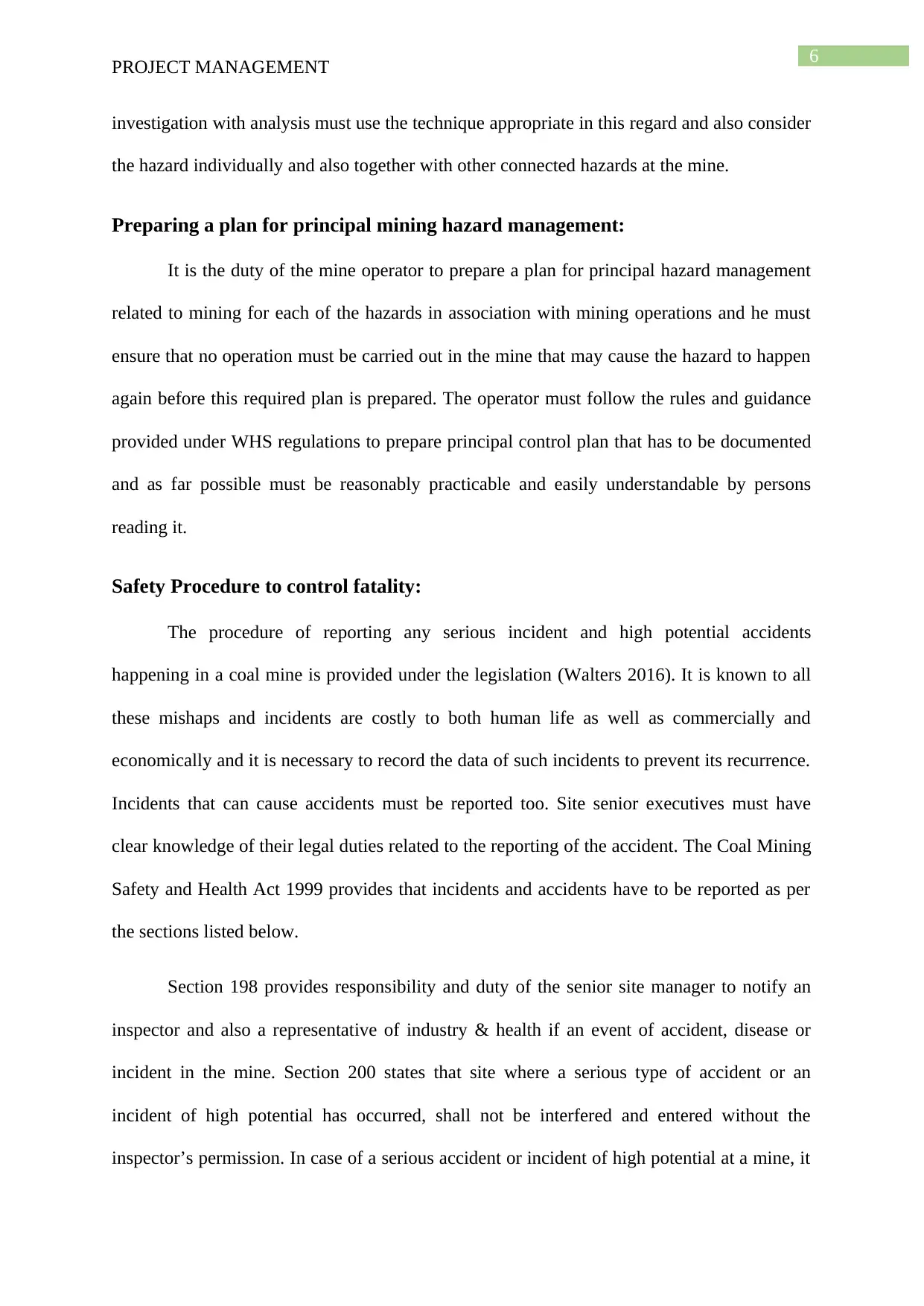
6
PROJECT MANAGEMENT
investigation with analysis must use the technique appropriate in this regard and also consider
the hazard individually and also together with other connected hazards at the mine.
Preparing a plan for principal mining hazard management:
It is the duty of the mine operator to prepare a plan for principal hazard management
related to mining for each of the hazards in association with mining operations and he must
ensure that no operation must be carried out in the mine that may cause the hazard to happen
again before this required plan is prepared. The operator must follow the rules and guidance
provided under WHS regulations to prepare principal control plan that has to be documented
and as far possible must be reasonably practicable and easily understandable by persons
reading it.
Safety Procedure to control fatality:
The procedure of reporting any serious incident and high potential accidents
happening in a coal mine is provided under the legislation (Walters 2016). It is known to all
these mishaps and incidents are costly to both human life as well as commercially and
economically and it is necessary to record the data of such incidents to prevent its recurrence.
Incidents that can cause accidents must be reported too. Site senior executives must have
clear knowledge of their legal duties related to the reporting of the accident. The Coal Mining
Safety and Health Act 1999 provides that incidents and accidents have to be reported as per
the sections listed below.
Section 198 provides responsibility and duty of the senior site manager to notify an
inspector and also a representative of industry & health if an event of accident, disease or
incident in the mine. Section 200 states that site where a serious type of accident or an
incident of high potential has occurred, shall not be interfered and entered without the
inspector’s permission. In case of a serious accident or incident of high potential at a mine, it
PROJECT MANAGEMENT
investigation with analysis must use the technique appropriate in this regard and also consider
the hazard individually and also together with other connected hazards at the mine.
Preparing a plan for principal mining hazard management:
It is the duty of the mine operator to prepare a plan for principal hazard management
related to mining for each of the hazards in association with mining operations and he must
ensure that no operation must be carried out in the mine that may cause the hazard to happen
again before this required plan is prepared. The operator must follow the rules and guidance
provided under WHS regulations to prepare principal control plan that has to be documented
and as far possible must be reasonably practicable and easily understandable by persons
reading it.
Safety Procedure to control fatality:
The procedure of reporting any serious incident and high potential accidents
happening in a coal mine is provided under the legislation (Walters 2016). It is known to all
these mishaps and incidents are costly to both human life as well as commercially and
economically and it is necessary to record the data of such incidents to prevent its recurrence.
Incidents that can cause accidents must be reported too. Site senior executives must have
clear knowledge of their legal duties related to the reporting of the accident. The Coal Mining
Safety and Health Act 1999 provides that incidents and accidents have to be reported as per
the sections listed below.
Section 198 provides responsibility and duty of the senior site manager to notify an
inspector and also a representative of industry & health if an event of accident, disease or
incident in the mine. Section 200 states that site where a serious type of accident or an
incident of high potential has occurred, shall not be interfered and entered without the
inspector’s permission. In case of a serious accident or incident of high potential at a mine, it
Paraphrase This Document
Need a fresh take? Get an instant paraphrase of this document with our AI Paraphraser
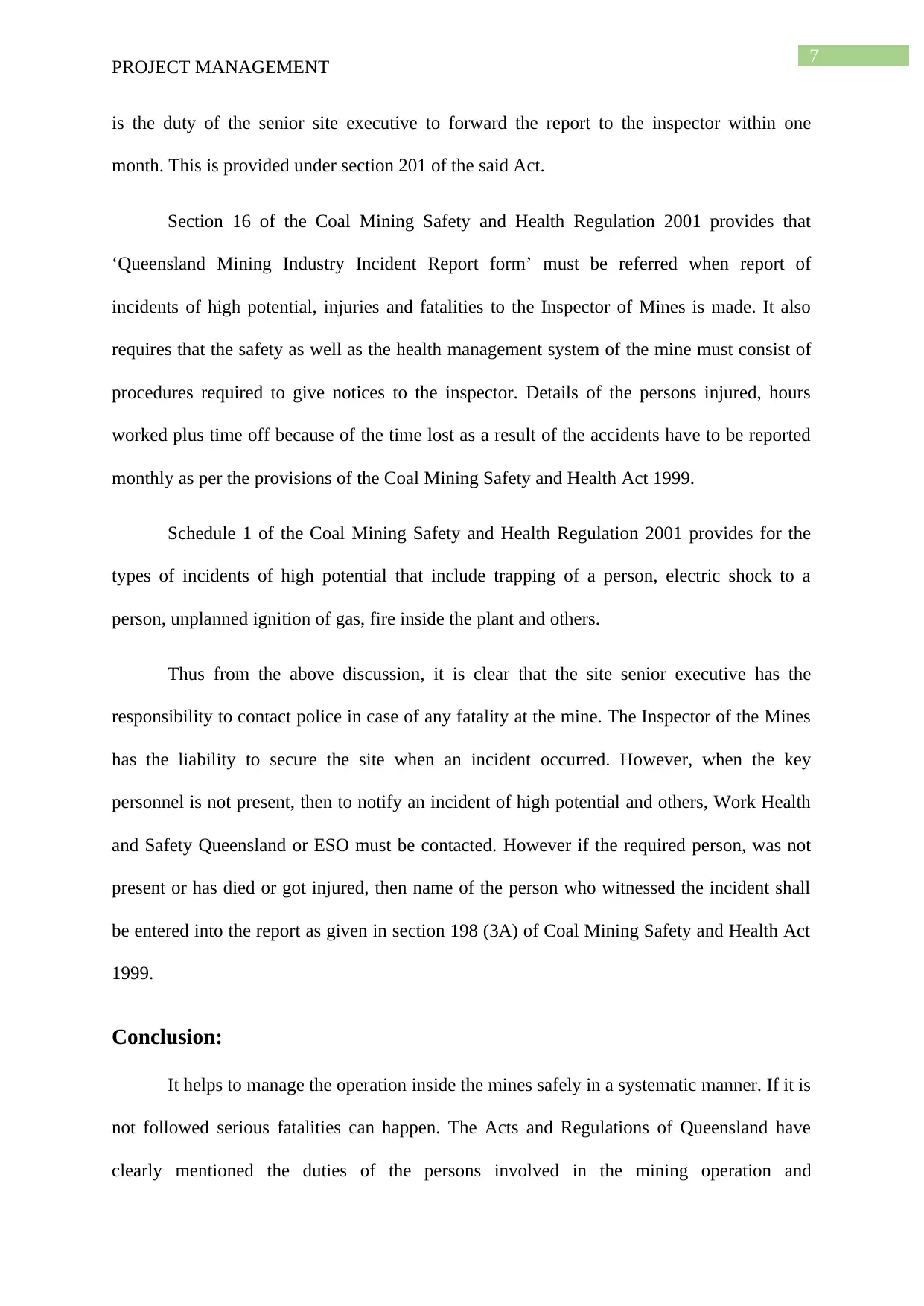
7
PROJECT MANAGEMENT
is the duty of the senior site executive to forward the report to the inspector within one
month. This is provided under section 201 of the said Act.
Section 16 of the Coal Mining Safety and Health Regulation 2001 provides that
‘Queensland Mining Industry Incident Report form’ must be referred when report of
incidents of high potential, injuries and fatalities to the Inspector of Mines is made. It also
requires that the safety as well as the health management system of the mine must consist of
procedures required to give notices to the inspector. Details of the persons injured, hours
worked plus time off because of the time lost as a result of the accidents have to be reported
monthly as per the provisions of the Coal Mining Safety and Health Act 1999.
Schedule 1 of the Coal Mining Safety and Health Regulation 2001 provides for the
types of incidents of high potential that include trapping of a person, electric shock to a
person, unplanned ignition of gas, fire inside the plant and others.
Thus from the above discussion, it is clear that the site senior executive has the
responsibility to contact police in case of any fatality at the mine. The Inspector of the Mines
has the liability to secure the site when an incident occurred. However, when the key
personnel is not present, then to notify an incident of high potential and others, Work Health
and Safety Queensland or ESO must be contacted. However if the required person, was not
present or has died or got injured, then name of the person who witnessed the incident shall
be entered into the report as given in section 198 (3A) of Coal Mining Safety and Health Act
1999.
Conclusion:
It helps to manage the operation inside the mines safely in a systematic manner. If it is
not followed serious fatalities can happen. The Acts and Regulations of Queensland have
clearly mentioned the duties of the persons involved in the mining operation and
PROJECT MANAGEMENT
is the duty of the senior site executive to forward the report to the inspector within one
month. This is provided under section 201 of the said Act.
Section 16 of the Coal Mining Safety and Health Regulation 2001 provides that
‘Queensland Mining Industry Incident Report form’ must be referred when report of
incidents of high potential, injuries and fatalities to the Inspector of Mines is made. It also
requires that the safety as well as the health management system of the mine must consist of
procedures required to give notices to the inspector. Details of the persons injured, hours
worked plus time off because of the time lost as a result of the accidents have to be reported
monthly as per the provisions of the Coal Mining Safety and Health Act 1999.
Schedule 1 of the Coal Mining Safety and Health Regulation 2001 provides for the
types of incidents of high potential that include trapping of a person, electric shock to a
person, unplanned ignition of gas, fire inside the plant and others.
Thus from the above discussion, it is clear that the site senior executive has the
responsibility to contact police in case of any fatality at the mine. The Inspector of the Mines
has the liability to secure the site when an incident occurred. However, when the key
personnel is not present, then to notify an incident of high potential and others, Work Health
and Safety Queensland or ESO must be contacted. However if the required person, was not
present or has died or got injured, then name of the person who witnessed the incident shall
be entered into the report as given in section 198 (3A) of Coal Mining Safety and Health Act
1999.
Conclusion:
It helps to manage the operation inside the mines safely in a systematic manner. If it is
not followed serious fatalities can happen. The Acts and Regulations of Queensland have
clearly mentioned the duties of the persons involved in the mining operation and
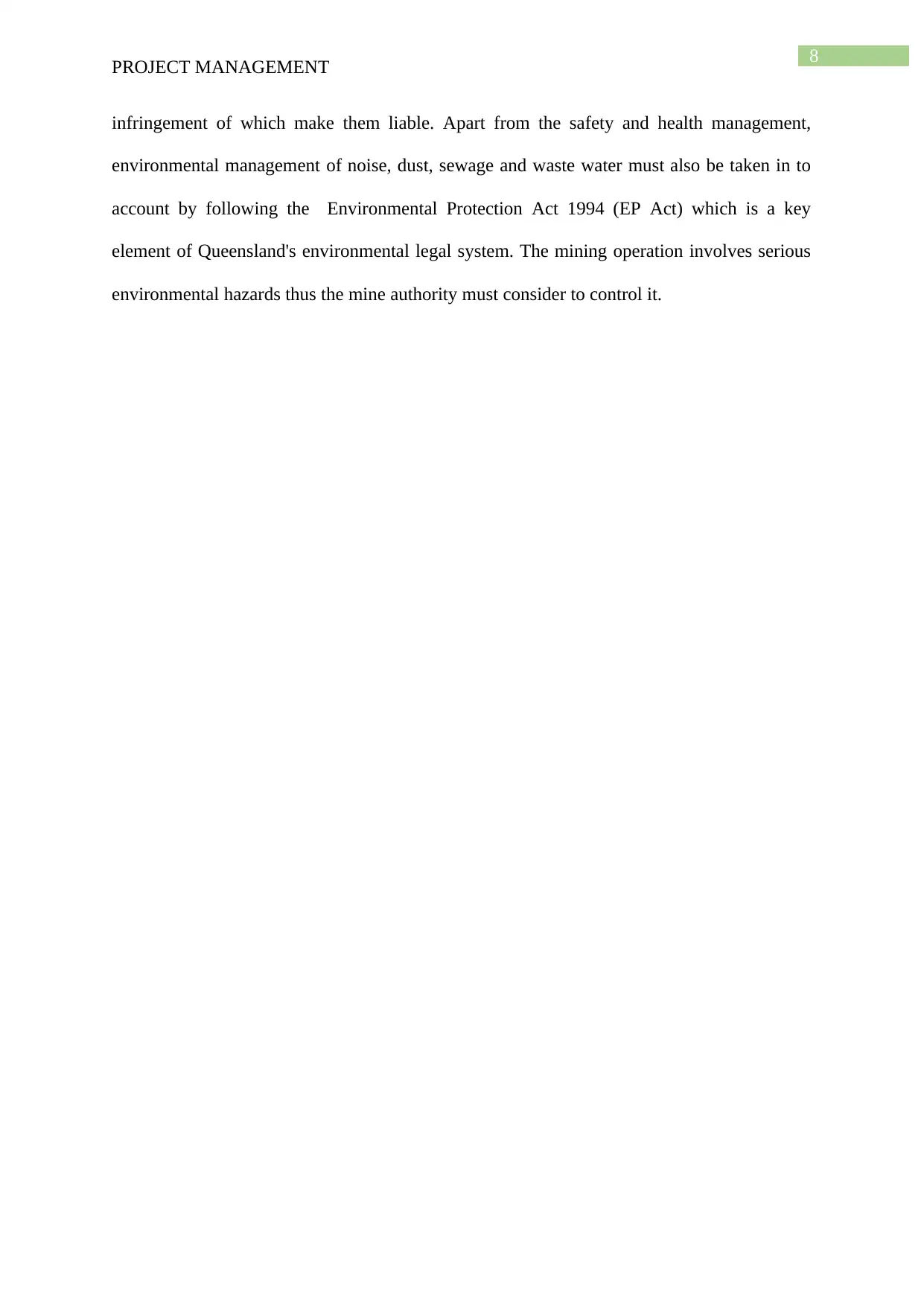
8
PROJECT MANAGEMENT
infringement of which make them liable. Apart from the safety and health management,
environmental management of noise, dust, sewage and waste water must also be taken in to
account by following the Environmental Protection Act 1994 (EP Act) which is a key
element of Queensland's environmental legal system. The mining operation involves serious
environmental hazards thus the mine authority must consider to control it.
PROJECT MANAGEMENT
infringement of which make them liable. Apart from the safety and health management,
environmental management of noise, dust, sewage and waste water must also be taken in to
account by following the Environmental Protection Act 1994 (EP Act) which is a key
element of Queensland's environmental legal system. The mining operation involves serious
environmental hazards thus the mine authority must consider to control it.
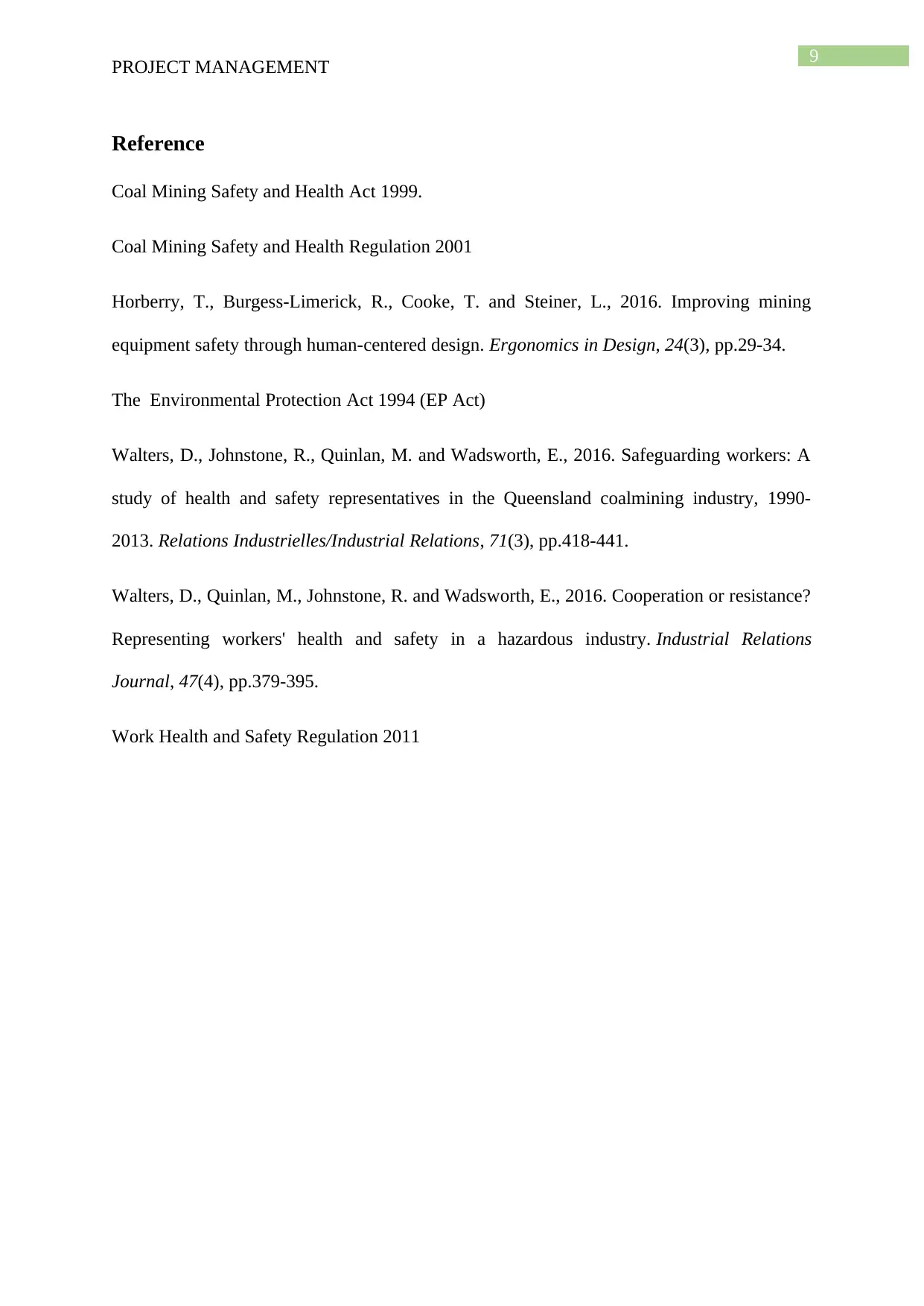
9
PROJECT MANAGEMENT
Reference
Coal Mining Safety and Health Act 1999.
Coal Mining Safety and Health Regulation 2001
Horberry, T., Burgess-Limerick, R., Cooke, T. and Steiner, L., 2016. Improving mining
equipment safety through human-centered design. Ergonomics in Design, 24(3), pp.29-34.
The Environmental Protection Act 1994 (EP Act)
Walters, D., Johnstone, R., Quinlan, M. and Wadsworth, E., 2016. Safeguarding workers: A
study of health and safety representatives in the Queensland coalmining industry, 1990-
2013. Relations Industrielles/Industrial Relations, 71(3), pp.418-441.
Walters, D., Quinlan, M., Johnstone, R. and Wadsworth, E., 2016. Cooperation or resistance?
Representing workers' health and safety in a hazardous industry. Industrial Relations
Journal, 47(4), pp.379-395.
Work Health and Safety Regulation 2011
PROJECT MANAGEMENT
Reference
Coal Mining Safety and Health Act 1999.
Coal Mining Safety and Health Regulation 2001
Horberry, T., Burgess-Limerick, R., Cooke, T. and Steiner, L., 2016. Improving mining
equipment safety through human-centered design. Ergonomics in Design, 24(3), pp.29-34.
The Environmental Protection Act 1994 (EP Act)
Walters, D., Johnstone, R., Quinlan, M. and Wadsworth, E., 2016. Safeguarding workers: A
study of health and safety representatives in the Queensland coalmining industry, 1990-
2013. Relations Industrielles/Industrial Relations, 71(3), pp.418-441.
Walters, D., Quinlan, M., Johnstone, R. and Wadsworth, E., 2016. Cooperation or resistance?
Representing workers' health and safety in a hazardous industry. Industrial Relations
Journal, 47(4), pp.379-395.
Work Health and Safety Regulation 2011
1 out of 10
Related Documents
Your All-in-One AI-Powered Toolkit for Academic Success.
+13062052269
info@desklib.com
Available 24*7 on WhatsApp / Email
![[object Object]](/_next/static/media/star-bottom.7253800d.svg)
Unlock your academic potential
© 2024 | Zucol Services PVT LTD | All rights reserved.





